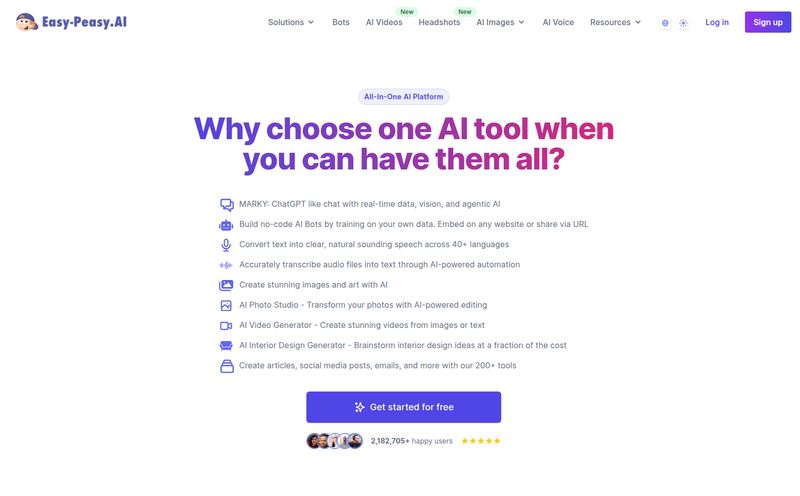We've all been there. Staring at a blank wall, a dated kitchen, or a sad-looking backyard, trying to picture what it could be. You spend hours scrolling through Pinterest, saving a chaotic mix of Scandinavian minimalism and bold, maximalist clutter. You try to explain your vision to your partner, who just nods blankly. The gap between the idea in your head and reality is a chasm, wide and deep.
For years, bridging that gap meant either learning complex 3D modeling software (looking at you, SketchUp), hiring an expensive designer, or just taking a leap of faith with a paint color you'll probably regret. But the AI wave is crashing over every industry, and yes, that includes the world of architecture and interior design. And that's where a tool like ArchitectGPT comes in.
I’ve been hearing the buzz about it for a while now in some of my professional circles, so I decided to roll up my sleeves and see if it's just another shiny AI toy or a genuinely useful tool. Is it the future of design, or just a fancy mood board generator? Let's get into it.
So, What Exactly Is ArchitectGPT?
In the simplest terms, ArchitectGPT is a web-based AI tool that transforms photos of your space into new design concepts. You snap a picture of your living room, upload it, pick a theme like "Modern Farmhouse" or "Industrial Loft," and the AI spits out a photorealistic render of what your room would look like after a full-blown makeover. It's like having an impossibly fast, incredibly versatile interior designer on call 24/7. No ego, no exorbitant fees. Just ideas on demand.
But it goes a bit deeper than just slapping a new style on a photo. It's built for virtual staging, redesigns, landscape planning, and even turning basic floor plans into something tangible and beautiful. The whole pitch is about speed and visualization—closing that chasm I was talking about earlier.

Visit ArchitectGPT
The Core Features That Actually Matter
Any new tool can boast a long list of features, but which ones actually move the needle? After playing around with it, a few things really stood out to me as being more than just marketing fluff.
From Photo to Photorealistic in Seconds
This is the main event. The speed is genuinely impressive. I uploaded a picture of my admittedly cluttered home office, and within about a minute, I had a dozen different versions of it. One was a sleek, minimalist space with built-in oak shelving. Another was a cozy, dark academic library-style room I'd never have considered. The quality of the renders is high—not perfect, you can still sometimes spot the tell-tale shimmer of AI, but more than good enough to sell an idea or get inspired. It's a powerful way to break out of a creative rut.
The Magic Editor and Text-to-Design
Okay, this is where it starts to feel a bit like sorcery. The Pro plan includes a "Magic Editor." This isn't just about applying a pre-set theme. You can literally highlight a section of your image—say, the sofa—and type in "change to a green velvet chesterfield sofa." And it... just does it. It's not always flawless, but when it works, it's a jaw-dropper. This granular control is what separates it from more basic AI image generators. It understands context, which is a huge deal for design work.
More Than Just Pretty Pictures: Virtual Staging & 3D Plans
Here’s where the real ROI comes in for professionals. For real estate agents, the ability to virtually stage an empty property is a game-changer. An empty room feels cold; a beautifully staged room sells a lifestyle. ArchitectGPT makes this process almost trivial. You can even take a 2D floor plan or a CAD file and have the AI generate a fully furnished, photorealistic 3D version. I've spend years watching architects and developers struggle with this, using clunky software to get a fraction of the result. This feature alone could be worth the price of admission for the right user.
My Experience: The Good, The Bad, and The AI
No tool is perfect, right? I'm an SEO guy, I live in a world of trade-offs. ArchitectGPT is no different. It's brilliant, but it has its quirks.
The good is obvious. The time saving is immense. Brainstorming visual ideas, which used to take hours of mood-boarding and searching, now takes minutes. It’s a fantastic starting point. For a realtor trying to quickly show a client a home's potential, or a designer needing to produce multiple concepts fast, it's a massive productivity boost.
The bad? Well, sometimes the AI's choices are a little… predictable. If you're not careful with your prompts and theme selections, you can end up with something that looks like it came straight from a generic furniture catalogue. It's a tool for ideation, but it's not a substitute for a human designer's unique taste and problem-solving skills. You still need a good eye to guide it. And let's be honest, giving up that much creative control can be frustrating for seasoned pros.
And then there's the AI of it all. The most powerful features, like the PlanVision Assistant and Architect Pro (which are still being rolled out), require a ChatGPT Plus subscription on top of your ArchitectGPT plan. It's a small detail mentioned in the fine print, but its a crucial one. It feels a bit like buying a car and then finding out you need a separate subscription to use the cool infotainment system.
Let's Talk Money: Breaking Down ArchitectGPT's Pricing
So what does all this AI magic cost? The pricing is tiered, which makes sense. You pay for the volume and the power you need. I've broken it down into a simple table, because who has time to parse complicated pricing pages?
| Plan | Price (Monthly) | Who It's For | Key Features |
|---|---|---|---|
| Basic | $25/mo | DIY Enthusiasts, Homeowners | Up to 300 images/month, 35+ themes, commercial use with attribution. |
| Standard | $45/mo | Freelancers, Small Design Firms | 1000 images/month, 55+ themes, more room/landscape options. |
| Pro | $90/mo | Real Estate Agencies, Architects, Power Users | Unlimited images, Magic Editor, 360° Panoramas, no-attribution commercial use, priority access. |
The Basic plan is a great entry point for anyone curious about redesigning their own space. But for any serious professional use, you’re realistically looking at the Standard or Pro plans. The unlimited generations and, crucially, the right to use images without giving attribution on the Pro plan is what agencies and serious realtors will need.
Who Should Actually Use ArchitectGPT?
After all this, who is this tool really for? I think it breaks down into a few camps:
- Real Estate Agents: This is a no-brainer. The virtual staging feature is killer. It’s a faster, cheaper alternative to physical staging and can dramatically improve a listing's appeal.
- Interior Designers: It’s a fantastic ideation tool. It won't replace you, but it can speed up your concept phase tenfold, allowing you to present clients with multiple, high-quality visual options in a fraction of the time.
- Architects & Developers: The ability to turn flat CAD drawings into vivid, realistic renders is hugely valuable for client presentations and marketing materials.
- DIY Homeowners: If you’re planning a renovation and feel visually stuck, the Basic plan is a relatively low-cost way to experiment with styles and get a clear vision before you start buying furniture or knocking down walls.
Frequently Asked Questions about ArchitectGPT
I've gotten a few DMs about this, so let's clear up some common questions.
Can I use ArchitectGPT for free?
No, there isn't a free plan. The entry-level plan is the Basic tier, which starts at $25 per month. They do offer a yearly discount if you commit for a longer term.
Do I need to install any special software?
Nope! It’s a fully web-based application. As long as you have an internet browser and a connection, you can use it from your computer or even your phone, which is handy for on-site visits.
Can I use the images for my business listings or portfolio?
Yes, you can. However, the Basic and Standard plans require you to provide attribution, meaning you have to credit ArchitectGPT. If you want to use the images without any attribution, you'll need the Pro plan.
How is this different from a generic AI image generator like Midjourney?
The main difference is its specialization. ArchitectGPT is trained specifically on architectural and interior design data. It has built-in features like virtual staging, theme selection, and the Magic Editor that are tailored for this specific purpose, giving you more relevant and controllable results than a general-purpose AI.
Do I really need a ChatGPT Plus subscription?
For the basic features, no. But for some of the most advanced, cutting-edge tools like the PlanVision Assistant and Architect Pro, the platform states that an active ChatGPT Plus account is required. It's an important factor to consider in the overall cost.
The Final Verdict: Is It a Revolution?
So, is ArchitectGPT the revolution it claims to be? I'd say... almost. It’s certainly a massive leap forward in making high-quality design visualization accessible to everyone. It's a powerful tool that can save professionals an incredible amount of time and empower homeowners with creative confidence.
It's not going to put good designers out of a job. If anything, it will become another tool in their belt, like Photoshop or AutoCAD before it. It handles the grunt work of ideation, freeing up humans to focus on the bigger picture: creating truly personal, functional, and innovative spaces.
For me, it's a definite 'yes'. It's a fascinating, powerful, and genuinely useful application of AI. It has its limitations and a pricing model that leans towards professionals, but the core technology is solid. It's taken my renovation daydreams and turned them into something I can almost touch. And for anyone who's ever been paralyzed by choice, that's a kind of magic that’s hard to put a price on.
Reference and Sources
- ArchitectGPT Official Website
- ArchitectGPT Pricing Page
- OpenAI's ChatGPT Information (For context on the required Plus subscription)



